
10686
.pdfA real depreciation of the value of US goods means a fall in a dollar’s purchasing power of EU products relative to a dollar’s purchasing power of US products.
This implies that US goods become less expensive and less valuable relative to the EU goods.
This implies that the value of US goods relative to value of EU goods falls.
qUS/EU = (E$/€ x PEU)/PUS
A real appreciation of the value of US goods means a rise in a dollar’s purchasing power of EU products relative to a dollar’s purchasing power of US products.
This implies that US goods become more expensive and more valuable relative to EU goods.
This implies that the value of US goods relative to value of EU goods rises.
•According to PPP, exchange rates are determined by relative price ratios:
E$/€ = PUS/PEU
•According to the more general real exchange rate approach, exchange rates may also be influenced by the real exchange rate:
E$/€ = qUS/EU x PUS/PEU
•What influences the real exchange rate?
•A change in relative demand for US products
•An increase in relative demand for US output causes the value (price) of US goods relative to the value (price) of foreign goods to rise.
•A real appreciation of the value of US goods: PUS rises relative to
E$/€ x PEU

•The real appreciation of the value of US goods makes US exports more expensive and imports into the US less expensive, thereby reducing relative quantity demanded.
•A decrease in relative demand for US output leads to a real depreciation of the value of US goods.
•A change in relative supply of US products
•An increase in relative supply for US output (caused by an increase in US productivity) causes the price/cost of US goods relative to the price/cost of foreign goods to fall.
•A real depreciation of the value of US goods: PUS falls relative to
E$/€ x PEU
•The real depreciation of the value of US goods makes US exports less expensive and imports into the US more expensive, thereby increasing relative demand to match increased relative supply.
•A decrease in relative supply for US output leads to a real appreciation of the value of US goods.
Determining the Long Run Real Exchange Rate
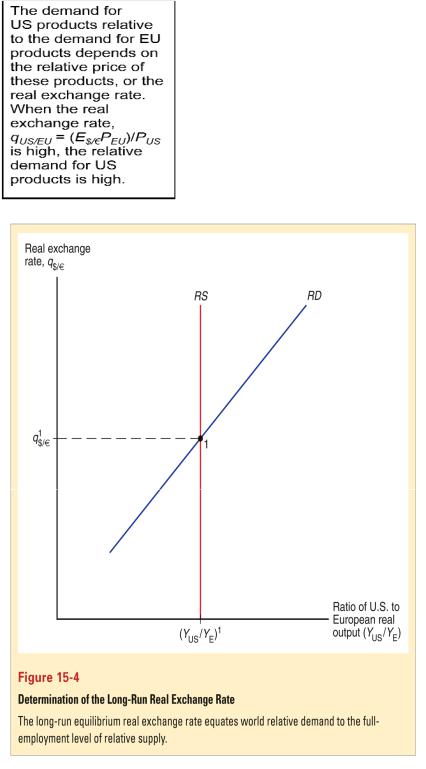
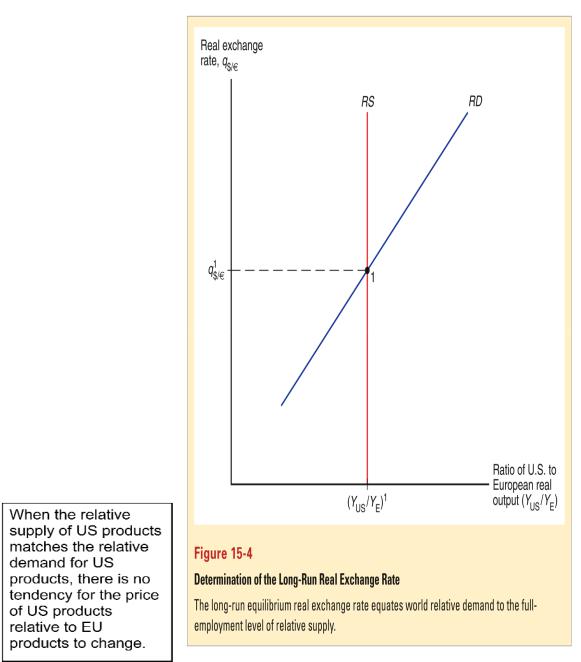
The Real Exchange Rate Approach to Exchange Rates
•The real exchange rate is a more general approach to explain exchange rates. Both monetary factors and real factors influence nominal exchange
rates:
1a. changes in monetary levels, leading to temporary inflation and changes in expectations about inflation.
1b. changes in monetary growth rates, leading to persistent inflation and changes in expectations about inflation.
2a.changes in relative demand: increase in relative demand for domestic products leads to a real appreciation.
2b. changes in relative supply: increase in relative supply for domestic products leads to a real depreciation.
• What are the effects on the nominal exchange rate?
E$/€ = qUS/EU x PUS/PEU
•When only monetary factors change and PPP holds, we have the same predictions as before.
no changes in the real exchange rate occurs
•When factors influencing real output change, the real exchange rate changes.
With an increase in relative demand for domestic products, the real exchange rate adjusts to determine nominal exchange rates.
With an increase in relative supply of domestic products, the situation is more complex…
•With an increase in the relative supply of domestic products, the real exchange rate adjusts to make the price/cost of domestic goods depreciate, but also the relative amount of domestic output increases.
This second effect increases the real money demand in the domestic economy relative to that in the foreign economy:
PUS = MsUS/L (R$, YUS)
The domestic price level decreases relative to the foreign price level.
The effect on the nominal exchange rate is ambiguous:
E$/€ = qUS/EU x PUS/PEU
•When economic changes are influenced only by monetary factors, and when the assumptions of PPP hold, nominal exchange rates are determined by PPP.
•When economic changes are caused by factors that affect real output, exchange rates are not determined by PPP only, but are also influenced by the real exchange rate.
Interest Rate Differences
•A more general equation of differences in nominal interest rates across countries can be derived from:
(qeUS/EU - qUS/EU)/qUS/EU = [(Ee$/€ - E$/€)/E$/€] – ( eUS - eEU) R$ - R€ = (Ee$/€ - E$/€)/E$/€
R$ - R€ = (qeUS/EU - qUS/EU)/qUS/EU + ( eUS - eEU)
•The difference in nominal interest rates across two countries is now the sum of:
The expected rate of depreciation in the value of domestic goods relative to foreign goods
The expected inflation difference between the domestic economy and the foreign economy
Real Interest Rates
• Real interest rates are inflation-adjusted interest rates: re = R – πe
•where πe represents expected inflation and R represents nominal interest rates.
•Real interest rates are measured in terms of real output: what quantity of real goods and services can you earn in the future by saving real resources today?
•What should be the differences in real interest rates across countries?
• Real interest rate differentials are derived from
reUS – reEU = (R$ - eUS) - (R € - eEU)
R$ - R€ = (qeUS/EU - qUS/EU)/qUS/EU + ( eUS - eEU) reUS – reEU = (qeUS/EU - qUS/EU)/qUS/EU
•The last equation is called real interest parity.
It says that the differences in real interest rates (return on saving in terms of real resources earned) between countries is equal to the expected change in the value/price/cost of goods and services between countries.
Summary
1.The law of one price says that the same good in different competitive markets must sell for the same price, when transportation costs and barriers between markets are not important.
2.Purchasing power parity applies the law of one price for all goods and services among all countries.
Absolute PPP says that currencies of two countries have the same purchasing power.
Relative PPP says that changes in the nominal exchange rate between two countries equals the difference in the inflation rates between the two countries.
3.The monetary approach to exchange rates uses PPP, real money supply and real money demand.
Changes in the growth rate of the money supply influence inflation and exchange rates.
Expectations about inflation influence the exchange rate.
The Fisher effect shows that differences in nominal interest rates are equal to differences in inflation rates.
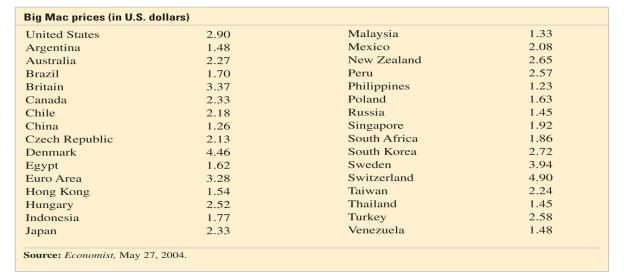
4.Empirical support for PPP is weak.
Trade barriers, non-tradable products, imperfect competition and differences in price measures may all have effects on the empirical shortcomings of PPP.
5.The real exchange rate approach to exchange rates generalizes the monetary approach.
It defines the real exchange rate as the value/price/cost of domestic products relative to foreign products.
It allows relative demand and relative supply changes to influence real and nominal exchange rates.
Interest rate differences are explained by a more general concept: expected changes in the value of domestic products relative to the value of foreign products plus the difference of inflation rates between the domestic and foreign economies.
6.Real interest rates are inflation-adjusted interest rates.
7.Real interest parity shows that differences in real interest rates between countries equal expected changes in the real value of goods and services between countries.
Law of One Price for Hamburgers?
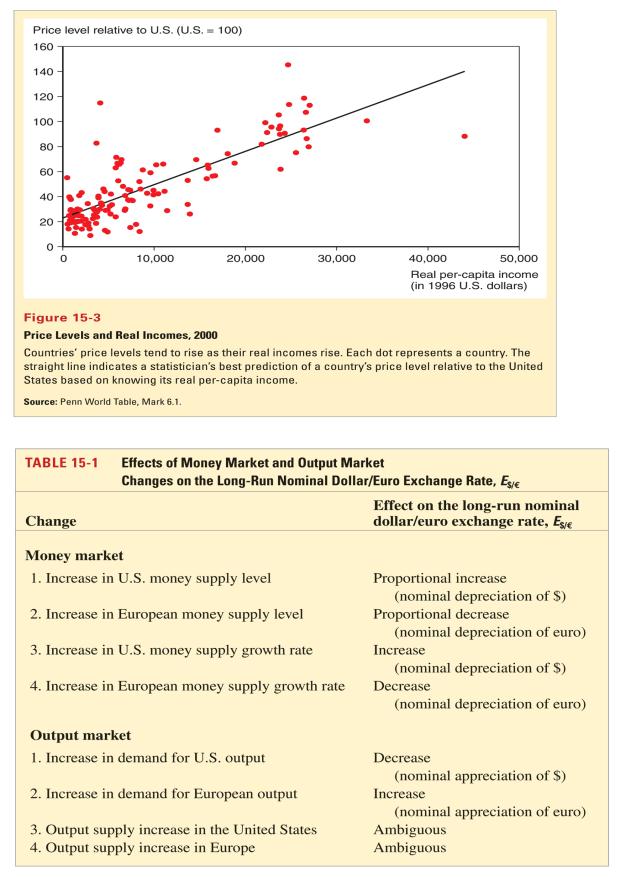
Price Levels and Incomes
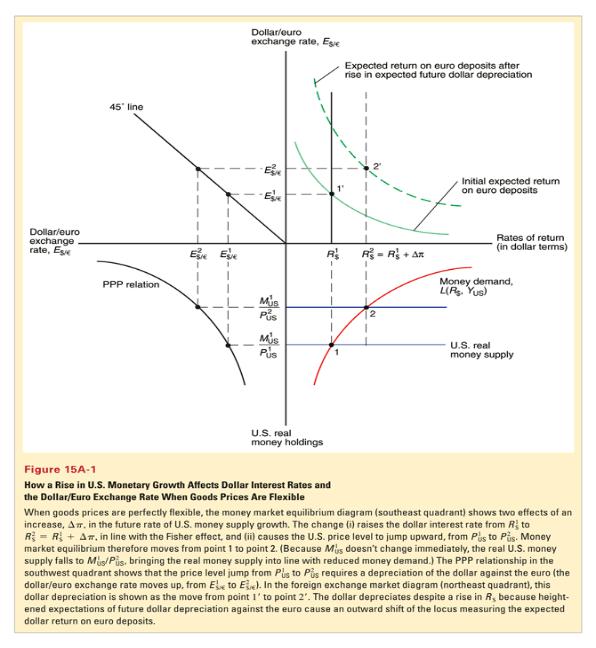
Chapter 16
Output and the Exchange Rate in the Short Run
Preview
•Determinants of aggregate demand in the short run
•A short run model of output market equilibrium
